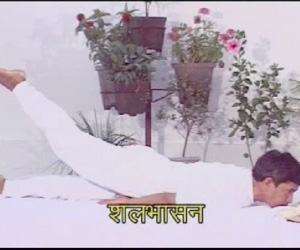Shalabhasana | Locust Pose
Shalabhasana in Sanskrit means ‘locust’. This posture resembles a locust.
Process-1
1. Keeping face downwards lie flat on abdomen and chest.
2. Place hands under each thigh
3. Now breathing in lift the right leg up, do not bend the knee.
4. Repeat this from other leg.
5. Repeat it two to four times.
Process-2
1. Keeping face downwards lie flat on abdomen and chest.
2. Now move the right hand above the head straight, touching the ear and head.
3. Place the left hand over the waist.
4. Now while inhaling, lift the right hand and head and left foot from ground.
5. Remain in this position for sometime and return to start position while breathing out.
6. Relax for sometime to repeat it from other side.
Process-3
1. Keeping face downwards lie flat on abdomen and chest.
2. Now place both hands over the back and each wrist with other hand.
3. While inhaling, first lift the chest first then lift the legs from ground.
4. After holding for sometime return to first position while breathing out.
Duration
Do it for four to five times.
Benefits
- This posture is good for hips,thighs,legs,buttocks,lower abdomen, wrists and diaphragm.
- Strengthen the muscles of the back.
- Useful in sciatica and back ache.
- Useful in spinal disease and cervical spondylitis.
- Reduces fat around thighs,hips,waist, and abdomen.
Precaution
- Avoid doing it after getting surgery to avoid complication.
- They should practice Ardh Shalabhasana for a few weeks first then switch over to this posture.
- Avoid clenching the fists too tight or too loose.
- Control the breathing while doing this asana
